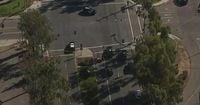On a busy Wednesday afternoon in Escondido, California, what began as a series of frantic 911 calls about a man with a knife escalated into a dramatic police shooting at a bustling city intersection. The events of November 26, 2025, have sparked intense public interest, as video footage, eyewitness accounts, and official statements shed light on a confrontation that left one man critically injured and raised questions about police tactics, mental health, and public safety.
According to multiple reports from ABC 10News, NBC 7, and Times of San Diego, the incident unfolded just after noon. At approximately 12:10 p.m., Escondido Police Department dispatchers began receiving a flurry of calls from motorists and bystanders near the intersection of West Felicita Avenue and South Centre City Parkway. Callers described a man—later identified as 54-year-old Juan Ramos—screaming, brandishing a knife, and jumping in front of moving cars. The situation quickly grew more dire as Ramos moved northward, walking in the southbound lanes toward the intersection of 13th Avenue and Centre City Parkway, about half a mile from the initial reports.
As officers sped to the scene, a plainclothes Escondido Police detective was the first to arrive. According to Lt. Chris Tivanian of the San Diego Police Department Homicide Unit, who is leading the investigation due to a regional protocol, the detective exited his vehicle just as additional uniformed officers pulled up. At that moment, Ramos, still holding the knife, charged at the detective. In a split-second response, the detective and two uniformed officers fired their handguns, striking Ramos and knocking him to the ground.
But the confrontation was far from over. As captured in video footage obtained by OnScene.TV and described by NBC 7, Ramos writhed on the ground, then staggered back to his feet, the knife still in his hand. Officers repeatedly shouted commands for him to drop the weapon and stay down. Instead, Ramos advanced again toward the officers, prompting a second volley of gunfire. In total, at least a dozen shots were fired in two separate bursts, according to ABC 10News.
Despite his injuries, Ramos attempted to rise yet again. Officers, demonstrating what Lt. Tivanian later called "incredible restraint," transitioned to using less-lethal force. They deployed a 40 millimeter rubber bullet weapon system, firing four to five rounds. One of these projectiles finally knocked the knife from Ramos' grasp, creating an opening for officers to move in and restrain him on the ground. As NBC 7 noted, about a dozen officers were involved in securing Ramos and providing immediate medical attention.
The intersection, a major artery in Escondido, was quickly cordoned off. Sky10 aerial footage and photos from the scene showed police vehicles blocking traffic, bloodied clothing on the pavement, and investigators working for hours to gather evidence. Centre City Parkway remained closed from 13th Avenue to Felicita Avenue well into the afternoon, causing significant disruption for commuters and local businesses.
Ramos was transported to Palomar Hospital, where he underwent surgery for his injuries. Police later confirmed he was expected to survive. He now faces charges of assaulting a peace officer with a deadly weapon and attempted murder, according to statements from the San Diego Police Department and NBC 7. No officers or bystanders were injured during the incident, a fact repeatedly emphasized by officials at the scene.
Lt. Tivanian spoke to the gravity of the officers' decision-making under pressure, telling ABC 10News, "They do consider their backstop and what’s beyond that. They’re responsible for every round that they fire. All of that goes into the split-second decision making processes." He added, "Considering what could’ve been, I think the officers did an outstanding job." Tivanian also highlighted the officers' efforts to provide medical help, saying, "Officers gave repeated orders for the suspect to drop the knife, that they wanted to get him help and attention for the gunshot wounds he'd incurred."
The officers involved in the shooting had varying levels of experience—two had served with the Escondido Police Department for about eight months and 17 years respectively, while the detective had been with the force for three years, according to NBC 7.
The identity of Ramos quickly became known in the local community. Residents told ABC 10News that he was a familiar figure in the area and known to be homeless. Police have not confirmed whether Ramos was under the influence of substances or experiencing a mental health crisis at the time, but said those factors would be investigated as part of the ongoing inquiry.
The San Diego Police Department assumed responsibility for the investigation, in keeping with a memorandum of understanding among San Diego County law enforcement agencies that prevents departments from investigating shootings involving their own officers. This protocol is designed to ensure impartiality and public trust in the aftermath of such incidents.
As the investigation continues, the episode has reignited debate over the intersection of law enforcement, homelessness, and mental health. While officials praised the restraint and professionalism of the officers, some community members and advocates have raised questions about whether alternative interventions or additional resources could have prevented the escalation. The incident also underscored the challenges officers face when confronting armed individuals in crowded public spaces, where the risk to bystanders is ever-present.
For many in Escondido, the events of November 26 serve as a stark reminder of the complexities and dangers inherent in modern policing. The images of a man in crisis, officers with weapons drawn, and a city intersection brought to a standstill will linger long after the police tape is cleared away. As new information emerges and the investigation unfolds, the community will be watching closely, searching for answers and hoping for lessons that might prevent future tragedies.




